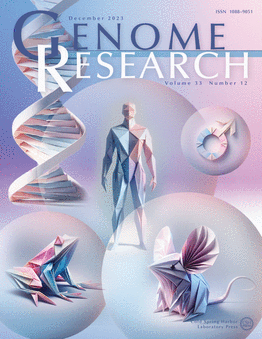一种低丰度的dicer依赖性sirna,由秀丽隐杆线虫的多种特征产生
IF 6.2
2区 生物学
Q1 BIOCHEMISTRY & MOLECULAR BIOLOGY
引用次数: 0
摘要
典型的小干扰RNA (sirna)是由Dicer和Argonautes结合的双链RNA (dsRNA)加工成直接RNA沉默的。在秀丽隐杆线虫中,22g - rna和26g - rna通常被称为sirna,但表现出不同的特征。例如,22g -RNA不起源于dsRNA,也不依赖于Dicer,而26g -RNA需要Dicer,但来自非典型RNA双工,并且完全反义地产生其信使RNA (mRNA)模板。为了鉴定秀丽隐杆线虫的典型sirna,我们首先鉴定了通过外源性RNA干扰(RNAi)途径产生的sirna。在RNAi过程中,dsRNA被加工成具有~ 2 nt, 3 ' -悬垂的~ 23 nt双链,最终产生不含5 ' g -含序列的sirna,这些序列与Argonaute RDE-1以及microRNA (Argonaute, ag -1)途径具有高亲和力。利用这些特征,我们搜索了它们的内源性对应物,并鉴定了数千个内源性位点,这些位点代表了几十种独特的元件,这些元件产生了低至中等水平的sirna,称为23h - rna。这些基因座包括重复元件、假定的编码基因、假基因、非编码rna和未注释的特征,其中许多采用发夹(hp)结构,使人想起果蝇和小鼠中的hpRNA/RNAi途径。RDE-1与其他Argonautes竞争与23h - rna的结合。当RDE-1缺失时,这些sirna在ALG-1和ALG-2复合物中富集。我们的研究结果扩展了秀丽隐杆线虫小rna及其Argonaute相互作用物的已知库,并证明内源性siRNA途径的关键特征在动物中相对不变。本文章由计算机程序翻译,如有差异,请以英文原文为准。
A low-abundance class of Dicer-dependent siRNAs produced from a variety of features in C. elegans
Canonical small interfering RNAs (siRNAs) are processed from double-stranded RNA (dsRNA) by Dicer and associate with Argonautes to direct RNA silencing. In Caenorhabditis elegans, 22G-RNAs and 26G-RNAs are often referred to as siRNAs but display distinct characteristics. For example, 22G-RNAs do not originate from dsRNA and do not depend on Dicer, whereas 26G-RNAs require Dicer but derive from an atypical RNA duplex and are produced exclusively antisense to their messenger RNA (mRNA) templates. To identify canonical siRNAs in C. elegans, we first characterized the siRNAs produced via the exogenous RNA interference (RNAi) pathway. During RNAi, dsRNA is processed into ∼23 nt duplexes with ∼2 nt, 3′-overhangs, ultimately yielding siRNAs devoid of 5′G-containing sequences that bind with high affinity to the Argonaute RDE-1, but also to the microRNA (miRNA) pathway Argonaute, ALG-1. Using these characteristics, we searched for their endogenous counterparts and identified thousands of endogenous loci representing dozens of unique elements that give rise to mostly low to moderate levels of siRNAs, called 23H-RNAs. These loci include repetitive elements, putative coding genes, pseudogenes, noncoding RNAs, and unannotated features, many of which adopt hairpin (hp) structures reminiscent of the hpRNA/RNAi pathway in flies and mice. RDE-1 competes with other Argonautes for binding to 23H-RNAs. When RDE-1 is depleted, these siRNAs are enriched in ALG-1 and ALG-2 complexes. Our results expand the known repertoire of C. elegans small RNAs and their Argonaute interactors, and demonstrate that key features of the endogenous siRNA pathway are relatively unchanged in animals.
求助全文
通过发布文献求助,成功后即可免费获取论文全文。
去求助
来源期刊

Genome research
生物-生化与分子生物学
CiteScore
12.40
自引率
1.40%
发文量
140
审稿时长
6 months
期刊介绍:
Launched in 1995, Genome Research is an international, continuously published, peer-reviewed journal that focuses on research that provides novel insights into the genome biology of all organisms, including advances in genomic medicine.
Among the topics considered by the journal are genome structure and function, comparative genomics, molecular evolution, genome-scale quantitative and population genetics, proteomics, epigenomics, and systems biology. The journal also features exciting gene discoveries and reports of cutting-edge computational biology and high-throughput methodologies.
New data in these areas are published as research papers, or methods and resource reports that provide novel information on technologies or tools that will be of interest to a broad readership. Complete data sets are presented electronically on the journal''s web site where appropriate. The journal also provides Reviews, Perspectives, and Insight/Outlook articles, which present commentary on the latest advances published both here and elsewhere, placing such progress in its broader biological context.
 求助内容:
求助内容: 应助结果提醒方式:
应助结果提醒方式:


